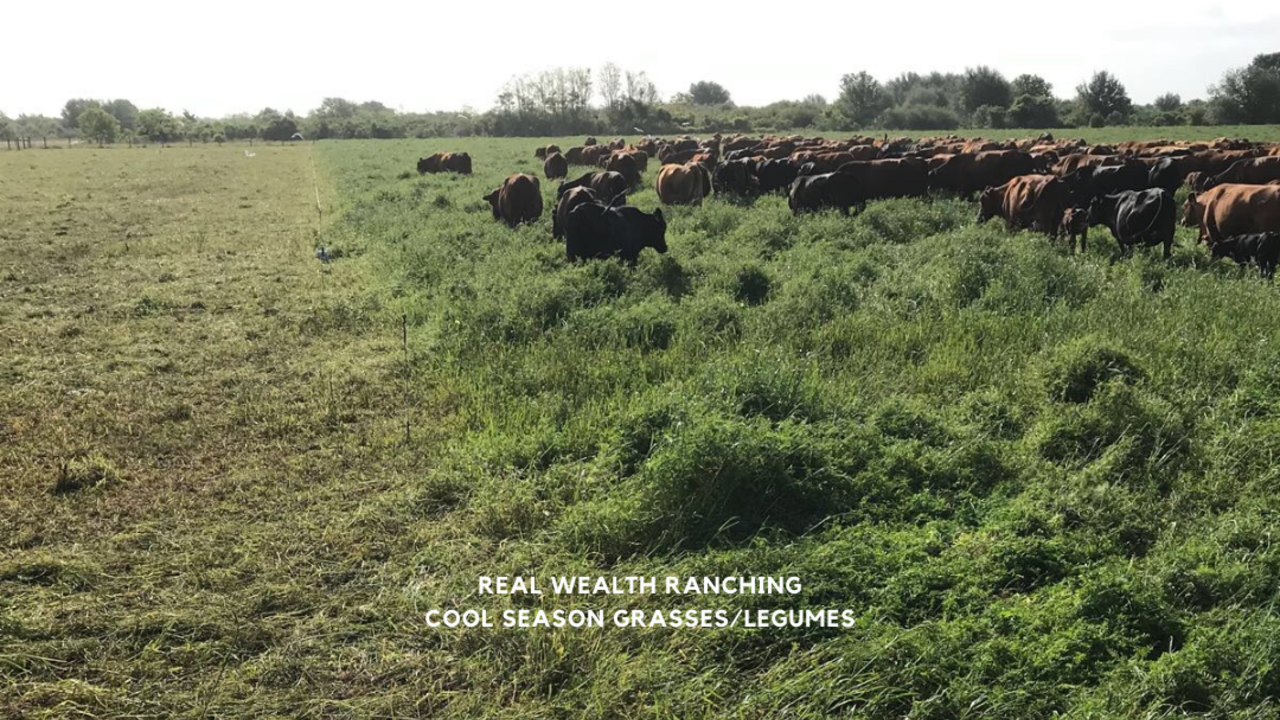How to manage cool season forage for maximum health and profits

Cool season grasses and legumes are VERY different in composition than warm season perennials.
When lush and growing fast they are very high in protein, low in fiber and their energy is in the form of sugars which causes acidosis and it’s the reason that the drying manure forms a white crust when this is not addressed.
The reason is that sugar is very high in oxygen or soluble carbohydrates on a dry matter basis, and if we consider the acidosis plus the excess ammonia produced in the rumen we can see why more health problems develop.
When such forages are digested the microorganisms in the rumen digest the carbohydrate portion of the excess amino acids belching, so to speak, the ammonia which being a gas goes through the rumen walls and enter the blood stream causing high pH.
This excess ammonia gas is also the main cause of frothy bloat.
While the rumen is having to cope with the lactic acid produced by the digestion of the high sugar content in these forages the blood and urine become alkaline, and we know that most pathogenic microorganisms in our cattle require a high pH to thrive and multiply.
Most common problems for ruminants grazing in this season on lush/green cool season grasses/legumes
- Mastitis
- Pink eye
- Foot rot
- Strawberry wart
- Scours
The excess pH also means that many nutrients and specially trace elements required to fight off infection aren’t able to get into the bloodstream from the digestive tract. We can observe this by checking the blood for trace elements at a good lab
Excess ammonia has symptoms much like nitrate poisoning, but these are milder.
- Panting
- Lower heat adaptation
- Lower fertility
- Higher morbidity
All of these lower our profits as the impact on their health affects it
Any microorganism requires the next conditions to grow and multiply
- Correct temperature
- Food source
- The microorganism
- Moisture
- The correct pH for that specific microorganism
The only factor we can control to better their health is the pH of their system, and we can do that with our management to where health problems diminish by 4 times and forage conversion efficiency improves by around 30%.
Best way is to allow the cools season forage to mature some more or have some brown with green to be non-selectively grazed as if allowed to select the animals go for the sweets first with the bad consequences to their health.
If not possible, then we can have them consume 5-8 pounds of straw or low protein/high fiber warm season perennial grass hay the first thing in the morning. Then, after they have consumed this nice smelling straw or low protein/high fiber hay we can start giving them their breaks which in this instance could be 3 per day as the straw feeding counts as one break.
- Optimum would be feeding straw at 8 am
- first grass break at 11 am
- second at 1 pm
- and last at 4 pm
It’s important that they are hungry early morning and full at last break, we need to be observant to follow my motto which is “fat cows, fat cows, fat cows”.
A fat cow can give us profits while a thin cow most always is difficult to sell!
If we give them a new break after 4 pm they may not be hungry enough to consume the straw in the morning, the same would happen if the grazing is selective instead of non-selective. We need to train our animals and not be trained by them, it’s for their own good health!
To increase stocking rate and our cattle health it’s important we understand how different forages, C3 or C4 in their composition.
C4 forages energy is mostly in the form of oils or fats while C3 forages energy is mostly in the form of sugars or soluble carbohydrates.
Sugars are very high in oxygen or soluble carbohydrates (55 % oxygen on a dry matter basis ) while fats or oils are very low in oxygen (13 % oxygen on a dry matter basis )
By providing good straw early morning we also allow the cool season forages to increase their energy levels by allowing photosynthesis to work as early morning is when energy is the lowest and nitrates or ammonia producing excess protein the highest
Remember, fat cows, fat cows, fat cows mean good body condition and not over fat.
Before you go, I have to ask you, are you truly interested in maximizing your profits while regenerating your land? If so, look out for the launch of the 4 Pillars of Real Wealth Ranching. Non-selective Grazing will be the first Pillar and it will come real soon.
Jaime Elizondo
